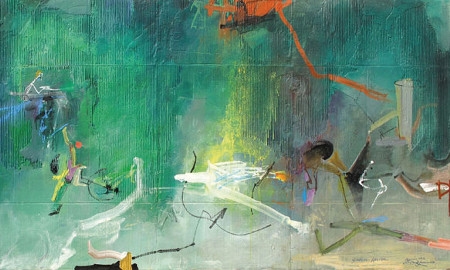The evolution of Bangladeshi art and culture is reflected in an organic timeline of creativity that spans unearthed prehistoric finds through to contemporary cutting-edge multimedia installations. Archaeological relics document a rich tradition in terracotta depicting everyday lives, mythological icons and revered deities.
Later discoveries in the Pala era (8th to 12th centuries) reveal flairs for illustrations on clothing, palm leaves and hand-made papers that were characterised by an essential harmony and delicate, decorative lines, which are now considered among the signature features of Bangladeshi art. Stylised geometric and floral designs or folk motifs, Alpanas, are also among the notable elements of Bengali folk art, as well as patochitra (depicting lores and legends on folded screens), some of which can even be found in mainstream ‘urban’ pieces today.
The roots of modern Bangladeshi, and Indian, art can be traced back to 1864 and the Calcutta Government School of Art, which greatly influenced both nations’ artistic heritage. Pioneers of the Bangladeshi modern art movement who studied and trained at the institution include Shilpacharya Zainul Abedin (1914-1976), Anwarul Huq (1918-1980), Qamrul Hassan (1921-1988), Safiuddin Ahmed (1922-2012) and Khwaja Shafiq Ahmed (1925-1972).
This eminent group of artists left Calcutta for Dhaka after the Partition of India in 1947 and the following year established the Dhaka Art College (which is now the Faculty of Fine Arts at the University of Dhaka).
Successive generations of imaginative, expressive, abstract and surrealist artists were subsequently formed and influenced by this first batch of pioneers. Later, post-independence artists demonstrated a new surge in creativity in the 1970s with many sculptors and print makers seeking to connect the old with the new.
“The single most dominant element to be noted in contemporary Bangladesh art perhaps has to do with the capacity of successive generations of artists to constantly discover anew their creative potential,” says Mohamed Mijarul Quayes, High Commissioner for Bangladesh to the UK.
“The debut on the world stage through La Biennale di Venezi, the Venice Biennale, in 2011 was in many ways a milestone in showcasing a brilliant morceau of cutting-edge creativity from Bangladesh.
This year, while we have flown our flag again at Venice, a second major opportunity for global showcasing has presented itself with Bangladesh’s participation in Japan’s Setouchi Triennale (held in Takamatsu from July 20 to September 1.) At Setouchi, the Bangladesh repertoire consists of an exhibition and a workshop segment and is particularly representative of contemporary art from Bangladesh. It brings together works by artists who have been active over the last five decades and more with a capacity to reinvent their own fortes and retain both a contemporary diction and appeal.”

0 COMMENTS